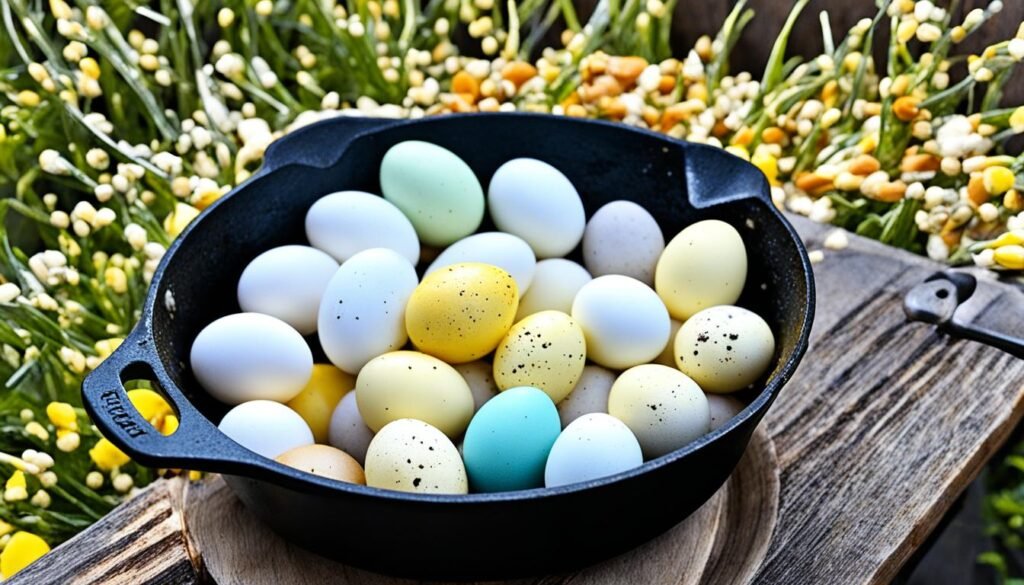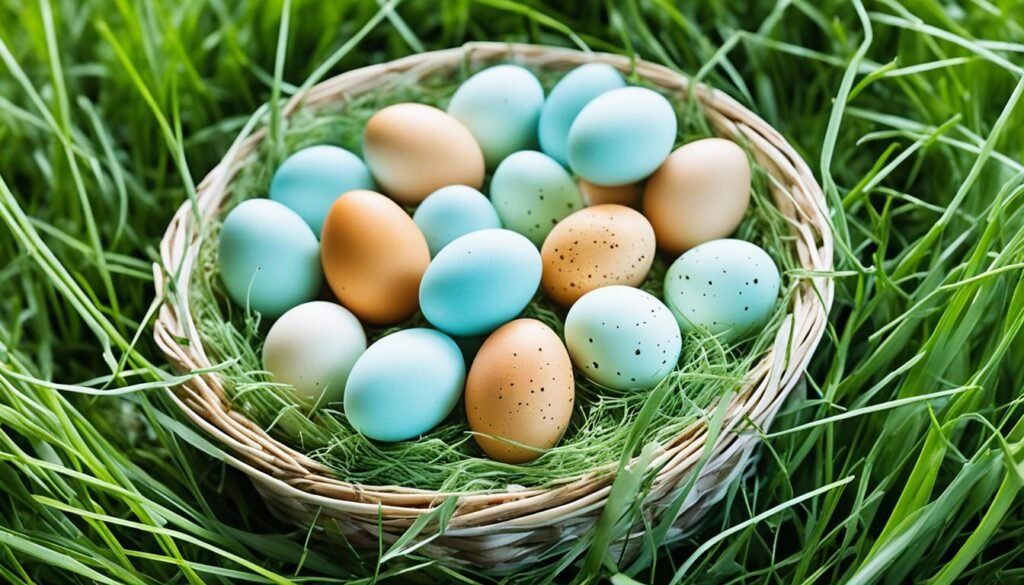Pullet eggs are small, flavorful gems from young hens. Often called “avian caviar,” these eggs offer unique benefits. They have a higher yolk-to-white ratio and thicker shells than regular poultry eggs.
These eggs showcase the variety of backyard chicken eggs and farm fresh eggs. Their rich, creamy texture provides a special culinary experience. Pullet eggs are a treat for those lucky enough to find them.
Table of Contents
ToggleKey Takeaways
- Pullet eggs are smaller than regular eggs, typically weighing 35g to 40g.
- They have a higher yolk-to-white ratio and stronger, thicker shells.
- Pullet eggs have deeper, more vibrant yolk colors and are very fresh.
- Their rich, creamy texture and flavor appeal to chefs and home cooks.
- These eggs may suit people with gluten-free or grain-free diets.
What are Pullet Eggs?
Pullet eggs come from young hens under a year old. These hens, called pullets, start laying around 18 weeks. Their eggs are smaller than regular ones but pack rich flavor.
Chefs and home cooks prize pullet eggs for their quality. Their vibrant yolks and unique traits make them stand out.
Delicious Eggs from Young Hens
Pullet eggs are about two-thirds the size of large eggs. They have a higher yolk-to-white ratio. Their yolks are intensely flavorful, and the whites are thick and luscious.
Young hens lay these small, fresh eggs with lighter shells. The eggs are known for their deep golden hue and rich taste.
| Characteristic | Pullet Eggs | Regular Eggs |
|---|---|---|
| Size | About two-thirds of a standard large egg | Standard large egg size |
| Yolk-to-White Ratio | Higher | Lower |
| Nutrient Content | Slightly lower | Standard |
| Shell Color | Lighter | Varies |
| Yolk Color | Deep golden hue | Varies |
| Flavor Profile | Intense and rich | Standard |
Pullet eggs are popular among chefs and home cooks. They’re used in various dishes, from miniature soufflés to elegant pasta.
“Pullet eggs are a real treasure for chefs and home cooks who appreciate the unique richness and vibrant color of the yolks.”
The Difference Between Pullet Eggs and Regular Eggs
Pullet eggs come from young hens and differ from regular eggs in size and quality. They’re smaller, about two-thirds of a standard large egg. Their shells are often lighter in color.
Pullet eggs have a higher yolk-to-white ratio than normal eggs. This gives them a richer, creamier texture. The larger yolk makes them stand out.
| Characteristic | Pullet Eggs | Regular Eggs |
|---|---|---|
| Egg Size | Smaller, about two-thirds the size of a large egg | Standard large egg size |
| Shell Color | Lighter shell color | Typical egg shell color |
| Yolk-to-White Ratio | Higher yolk-to-white ratio | Lower yolk-to-white ratio |
| Texture | Richer, creamier texture | Standard egg texture |
Pullet eggs may have fewer nutrients due to their smaller size. However, their freshness and unique qualities make them popular among food lovers.
“Pullet eggs are a real treat – their vibrant yolks and rich, creamy texture make them a standout ingredient in both sweet and savory dishes.”
Why Are pullet eggs So Hard to Find?
Pullet eggs are rare in many markets despite their delicious qualities. Regulators’ size standards force farmers to discard or repurpose these smaller eggs. This waste amounts to an estimated 1.5 million pullet eggs yearly.
Young hens lay pullet eggs during their first four weeks of laying. These eggs are smaller but offer a higher yolk-to-white ratio. They also have stronger shells and more vibrant yolks, indicating higher nutrient levels.
Saving the Seasonal Treat from Food Waste
A growing movement supports local farmers and sustainable practices. This allows consumers to enjoy these seasonal treasures and prevent food waste. Pullet eggs make up at least 10% of a farmer’s overall yield.
Buying pullet eggs directly from small, local producers offers many benefits. Consumers can enjoy their rich, creamy flavor and texture. They also help reduce food waste and support sustainable agriculture in their communities.
| Characteristic | Pullet Eggs | Regular Eggs |
|---|---|---|
| Size | Smaller | Larger |
| Yolk-to-White Ratio | Higher | Lower |
| Shell Strength | Stronger, Thicker | Thinner |
| Yolk Color | Deeper, More Vibrant | Lighter |
| Freshness | Very Fresh | Less Fresh |
Supporting local farmers and embracing pullet eggs’ seasonal availability has many benefits. Consumers can enjoy this unique treat while reducing food waste. They also promote sustainable farming practices in their area.
The Benefits of Pullet Eggs
Pullet eggs come from young hens in their first laying season. They offer more than just great taste. Their yolk-to-white ratio and deeper yolk color suggest higher nutrient levels, making them nutrient-rich.
Pullet eggs have thicker, more durable shells. This is great for those who value freshness or use eggs for crafts. These eggs can also be good for people with egg allergens.
- Pullet eggs often have a richer, creamier texture and flavor, making them ideal for recipes where the egg yolk quality is crucial, such as custards and pastries.
- The higher yolk-to-white ratio and deeper yolk color of pullet eggs can indicate higher levels of beneficial nutrients like carotenoids.
- Pullet eggs with thicker, more durable shells are advantageous for consumers who prioritize freshness or use eggs in decorative crafts.
- Pullet eggs raised on diets free of common allergens like corn and soy can be a suitable alternative for individuals with egg allergens.
Pullet eggs are special. They’re packed with nutrients and have a unique flavor. These eggs can be great for people with dietary needs. They’re a valuable addition to any kitchen.
Cooking and Baking with Pullet Eggs
Pullet eggs come from young hens and are great for cooking and baking. They have a firm texture and rich flavor. These eggs work well for frying, poaching, and hard-boiling.
You can use pullet eggs in baking too. Replace 2 large eggs with 3 pullet eggs in recipes. This swap can make baked goods richer and tastier.
Simple Preparations and Baking Substitutions
Pastry chefs love pullet eggs for their bigger yolk-to-white ratio. The yolks make pastries creamier. The whites help cakes become lighter and softer.
When using pullet eggs, add one extra egg compared to the recipe. Fresh eggs give the best results when baking with pullet eggs. Pullet eggs are smaller than extra-large commercial eggs.
| Recipe | Egg Substitution | Baking Time |
|---|---|---|
| Butter Cake with Pullet Egg Whites | 5 pullet egg whites | 30 minutes at 350°F |
The Butter Cake recipe needs 5 pullet egg whites. It also uses sifted sugar, organic pastry flour, and baking powder. Add salt, whole milk, butter, and vanilla extract too.
Bake the cake at 350 degrees for about 30 minutes. Check if it’s done with a toothpick.
Don’t waste the yolks from pullet eggs. Use them to make custard or egg yolk cookies. This way, you’ll use every part of these special eggs.
pullet eggs and Dietary Restrictions
Pullet eggs are a great option for those with dietary needs. They’re ideal for gluten-free and grain-free diets when raised on allergen-free feed. These small eggs offer a fresh, tasty choice for health-conscious people.
Studies show varied opinions on protein and energy needs for egg-laying pullets. A flock’s age at sexual maturity is crucial for profitable egg production. Significant body changes happen as pullets prepare to lay eggs.
Pullets’ body weight at 18 weeks stays similar regardless of diet energy. Higher energy diets make pullets “fatter” at 18 weeks. This can help pullets starting production in hot summers.
White Leghorn pullets on high-protein diets weigh slightly more at 16 weeks. Underweight pullets can reach mature weight quickly on dense diets. Good body weight at laying time is key for profitable egg production.
| Nutrient Levels in Layer Diets (at 100 grams per day intake level) | Range |
|---|---|
| Metabolizable Energy (MJ/Kg) | 11.20-11.97 |
| Crude Protein (%) |
|
| Calcium (%) |
|
Understanding pullets’ dietary needs and growth helps producers. They can ensure pullet eggs, gluten-free eggs, grain-free eggs, and allergen-free eggs are healthy options. These eggs cater to people with specific dietary needs or concerns.

“Pullet eggs can be a versatile and nutritious choice for individuals with dietary restrictions or food allergies, providing a fresh and flavorful alternative to regular eggs.”
Sourcing Fresh Pullet Eggs
Fresh pullet eggs are hard to find in regular grocery stores. But you can get these seasonal treats from local farms. These farms focus on sustainable egg production.
Support small-scale, organic farms like Hidden Camp Farm and Purton House Organics. You’ll enjoy top-quality pullet eggs and help farmers make a living. Plus, you’ll help keep this unique food available.
Supporting Local Farmers and Sustainable Practices
Pullet eggs are a short-lived treat. They’re only available when young hens start laying. To get these prized eggs regularly, connect with local farms.
Look for farms that use sustainable and humane practices. These farms let chickens roam free in pastures. The chickens eat a varied, natural diet.
- Seek out farms that allow their chickens to roam freely in pasture-based environments, providing them with a diverse, natural diet.
- Look for farms that use custom, low-PUFA (polyunsaturated fatty acid) feed, avoiding ingredients like corn, soy, and high-PUFA seeds and oils.
- Support farms that focus on regenerative agriculture, promoting soil health and a thriving ecosystem for their chickens.
Buying pullet eggs from these farms has many benefits. You’ll enjoy great taste and nutrition. You’ll also help keep this food tradition alive. And you’ll support hardworking farmers.
The Versatility of Pullet Eggs
Pullet eggs are small, nutrient-dense gems from young hens. They can enhance various dishes beyond typical egg preparations. These unique ingredients offer endless possibilities in cooking.
Their rich yolks and sturdy structure excel in custards and quiches. Pullet eggs create velvety textures and allow precise portioning in recipes.
In baking, these eggs substitute regular ones perfectly. They enhance cakes, cookies, and pastries with a delicate flavor. Their creamy texture complements both sweet and savory goods.
Cooking with pullet eggs or baking with pullet eggs opens up countless options. From fluffy omelets to decadent crème brûlée, these eggs elevate any dish. They’re a valuable addition to any cook’s toolkit.
“Pullet eggs are a hidden gem, offering a unique flavor and texture that can truly transform a recipe.”
More people are discovering the uses for pullet eggs in various egg recipes. As a result, demand for these flavorful eggs is growing. Try these seasonal treasures and let your creativity soar in the kitchen!

Celebrating the Season with Pullet Eggs
Pullet eggs are a brief delight, available for only about 4 weeks. Young hens produce these special eggs at the start of their laying cycle. Their short season makes these pullet eggs truly remarkable.
Savor pullet eggs in simple dishes like fried or poached eggs. They also shine in decadent baked goods. These eggs offer a unique taste during their limited availability.
A Fleeting Treat to Enjoy
Spring is prime time to celebrate with pullet eggs. It marks nature’s renewal. Hens can lay up to one egg every 25 hours now.
This results in plenty of small, flavorful eggs for pullet egg recipes. Don’t wait to try these seasonal gems. Visit your local farmers’ market or farm stand soon.
“Pullet eggs are a true taste of spring, and their limited availability makes them all the more special. Savor every bite while you can!”
Exploring the World of Backyard Eggs
Backyard egg production offers unique varieties beyond typical grocery store options. Home cooks can access diverse egg sizes, colors, and flavors from different chicken breeds. This exploration opens up exciting culinary possibilities while supporting local food systems.
Egg formation in hens takes about 25 hours from ovulation to laying. A rooster’s sperm can live in the hen’s sperm host gland for two weeks. The laying cycle varies from 12 days to a year, depending on the breed.
Backyard chickens produce eggs in various colors. These include white, brown, olive green, dark chocolate brown, and blue. Hens typically ovulate within 30 minutes after laying an egg.
| Egg Color | Chicken Breed | Flavor Profile |
|---|---|---|
| White | Leghorn | Mild, delicate |
| Brown | Rhode Island Red | Richer, creamier |
| Blue | Ameraucana | Earthy, nutty |
| Green | Olive Egger | Robust, savory |
Interest in backyard chickens has grown recently, with changes in urban ordinances. The COVID-19 pandemic boosted their popularity. People seek greater self-sustainability and connection to their food sources.
“Chickens exhibit cultural behaviors, learning habits from one another, showcasing the complex social dynamics within chicken flocks.”
Conclusion
Pullet eggs are a unique culinary delight. Their small size and rich flavor make them special. These eggs from young hens offer vibrant yolks and exceptional quality.
Sourcing pullet eggs can be challenging due to their seasonal nature. However, growing interest in local farming is making them more accessible. This trend supports sustainable practices and small-scale egg production.
The demand for sustainable farming and food transparency is increasing. This could lead to greater availability of pullet eggs. These eggs connect us to local agriculture’s seasonal rhythms.
Pullet eggs add a distinctive twist to various dishes. They shine when enjoyed on their own too. Supporting farmers who produce these eggs ensures their continued availability.
By embracing backyard egg diversity, we celebrate a unique food experience. Pullet eggs represent the artisanal nature of local agriculture. Their fleeting availability makes them even more special.
FAQ
What are pullet eggs?
Pullet eggs come from hens less than a year old, typically around 18 weeks. These young hens, called pullets, are just starting to lay eggs. Pullet eggs are noticeably smaller than regular eggs.
What are the differences between pullet eggs and regular eggs?
Pullet eggs come from younger hens, while regular eggs are from mature hens. This age difference results in several unique traits. Pullet eggs are smaller, have a higher yolk-to-white ratio, and deeper yolk color.
They also have thicker shells and a richer, creamier texture. These features make pullet eggs stand out from regular eggs.
Why are pullet eggs so hard to find?
Pullet eggs are rare because they don’t meet size standards set by regulators. Many farmers discard or repurpose these smaller eggs. This practice wastes millions of pullet eggs each year, despite their great flavor and freshness.
What are the benefits of pullet eggs?
Pullet eggs offer more than just great taste. Their higher yolk-to-white ratio and deeper color suggest more beneficial nutrients like carotenoids. The thicker shells are great for freshness and decorative crafts.
Pullet eggs from hens fed allergen-free diets can suit those with food sensitivities. These eggs are versatile and nutritious.
How can pullet eggs be used in cooking and baking?
Pullet eggs work well in many dishes. Their firm texture is perfect for fried, poached, and hard-boiled eggs. In baking, you can substitute pullet eggs for regular ones.
Use 3 pullet eggs for every 2 large eggs in a recipe. This simple swap allows you to enjoy these special eggs in various dishes.
Are pullet eggs suitable for individuals with dietary restrictions?
Yes, pullet eggs can be great for special diets. When hens eat allergen-free feed, their eggs suit gluten-free and grain-free diets. The unique qualities of pullet eggs make them versatile for health-conscious eaters.
Where can I find fresh pullet eggs?
Fresh pullet eggs are hard to find in regular grocery stores. You can get these seasonal treats directly from local farmers. Support small-scale, sustainable farms like Hidden Camp Farm and Purton House Organics for the best pullet eggs.

